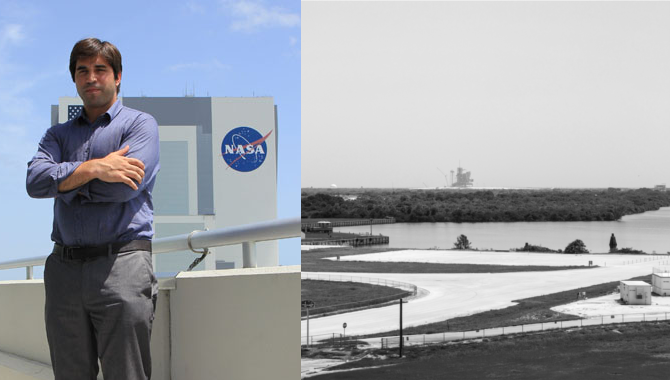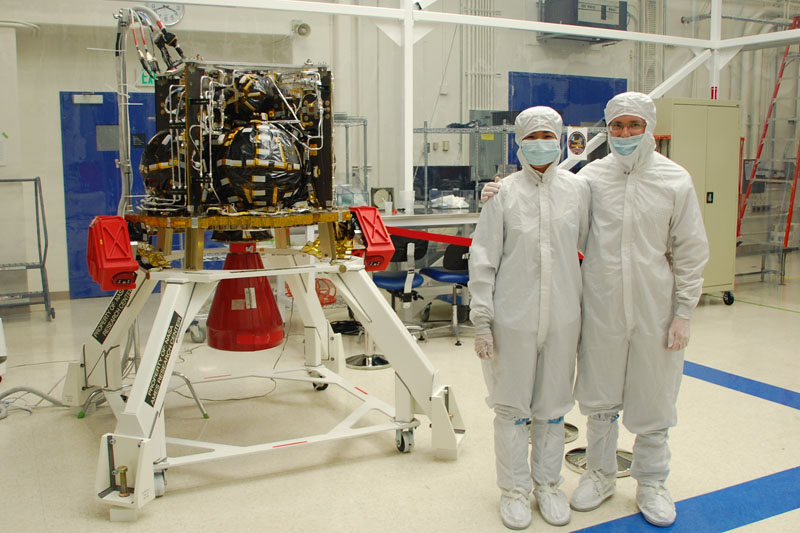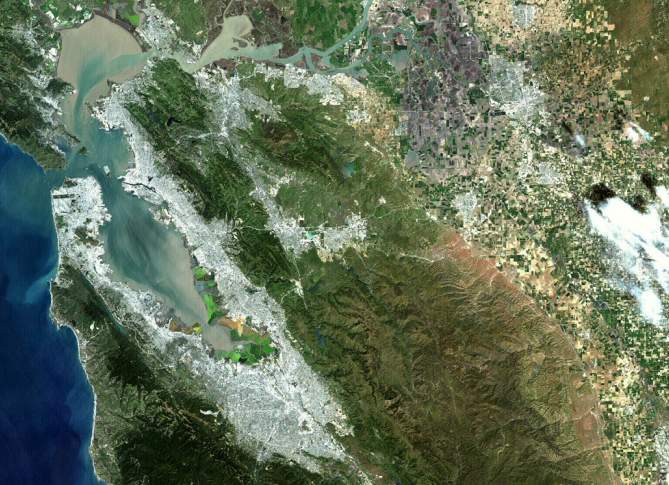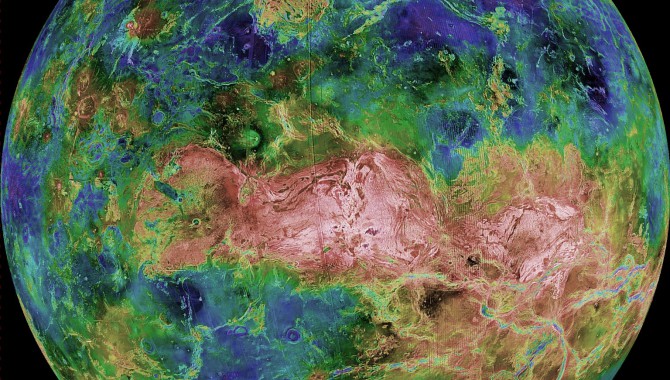
This hemispheric view of Venus, as revealed by more than a decade of radar investigations culminating in the 1990-1994 Magellan mission, is centered at 90 degrees east longitude. The Magellan spacecraft imaged more than 98 percent of Venus at a resolution of about 100 meters; the effective resolution of this image is about 3 kilometers. Credit: NASA/JPL-CalTech
July 31, 2012 Vol. 5, Issue 7
Hot, toxic, and murky, Venus serves as an extraordinary engineering challenge, according to Jim Garvin.

This picture by the Galileo spacecraft shows just how cloudy Venus is. Venus is very similar to Earth in size and mass – and so is sometimes referred to as Earth’s sister planet – but Venus has a quite different climate.
Photo Credit: Jet Propulsion Laboratory / Galileo spacecraft
Venus is bizarre. One day on Venus is nearly as long as one year on Earth. It rotates about its axis in the opposite direction of all the other planets in our solar system. Venus traps more solar energy than it can release and because it turns so slowly that its just about as hot on the night side as it is on the day side. As far as science and exploration are concerned, “It makes Mars look so good, says Jim Garvin, Chief Scientist for Goddard Space Flight Center. As the former NASA Chief Scientist for Mars exploration from 2000 to 2004, Garvin is well acquainted with the challenges of Mars exploration, but even he readily admits that Venus is in a league of its own.
The tools for learning more about the surface of Mars—orbiters, landers, and rovers to map, probe, and study the landscape and the compelling rocks—will not work very well for Venus. For one, theres the problem of the atmosphere. Its thick—really thick. One hundred times the mass of Earth’s, it’s the biggest atmosphere in the solar system other than Jupiter’s, explains Garvin, noting that its hot as Hades at the surface and theres toxic chemistry on descent, and that makes it hard to do the science we need in order to understand Venus.
To get to the surface, a lander (or rover) must fall through approximately 35km (~100,000ft) of the thick, murky lower atmosphere before the final couple of kilometers where the ground finally becomes visible from above. During descent, the temperature starts at a comfortable 20 degrees Celsius and shoots up to 450 degrees Celsius just before reaching the surface. (A standard kitchen oven runs at about 200 degrees Celsius.) Near the surface, the air is so thick that the lander will settle to the ground much like a stone settles in water—no retrorockets or sky cranes required.
Once on the surface, which is hot enough to melt lead, there is little more than an hour, maybe two, for the lander or rover to do the science it set out to perform. Performing experiments in the comfort of our own planet in only an hour is difficult enough. On Venus you have every other problem known to woman or man in a hard and unforgiving place, says Garvin.
“Venus is an engineering problem. We’re not without science questions to ask—there are plenty. But engineering is challenging there, he said. With an hour or so to do your work, without some other mechanism so you can get rid of heat longer, you have a fundamental problem.”
A Few Thousand Words
From 1961 to 1984, the Soviet Union launched a series of probes to Venus. Its Venera program consisted of sixteen massive probes, the first seven of which never reached the surface. Beginning with Venera 8 in 1972, the Soviets succeeded in being the first space agency to perform a soft landing on another planet and the only agency to ever retrieve images from the surface of Venus.

Venera 13 landing site panorama, side A (penetrometer side), in original perspective prior to transformation.
Credit: National Space Science Data Center
Meanwhile, Garvin was working on his graduate degree from Brown University under Professor James Head. Having spent some time working on Viking Lander images of Mars, Garvin became interested in the results of the Venera missions. I wrote a couple of little old papers in the early ’80s about Venera 9 and 10, comparing it to Mars imagery from Viking, he says. These publications later earned him and his mentor, Head, a trip to Soviet Russia to look over the latest Venera images when a Soviet scientist took interest in Garvin’s work and proposed a partnership that was later enabled by means of a scientific relationship through Brown University. Although highly controversial due to the political climate at the time, the payoff was worth it in terms of science.
Garvin and Head visited the Soviet Union several times. Due to a language barrier, some of communications took place in French. Fortunately I remembered it at the time, Garvin says. Both times they received large facsimile photographs as hardcopies depicting the latest images of the Venusian surface. “They scanned line by line by line by line. They would go all the way up and all the way back, like an old teletype machine,” Garvin said, moving his hand from left to right, explaining how the images were captured by the Venera landers. The data they gave us when I was finishing up at Brown in the mid-’80s, was stored on tapes that were bit-interleaved, which means there’s one bit of data, all this other telemetry, one bit of data, all of this other stuff—not the way we normally encode data from space at NASA.

Venera 14 landing site panorama, side A, prior to transformation.
Credit: National Space Science Data Center
To the untrained eye, the images of the surface of Venus might appear to be unimpressive. Each appears to be taken from a camera roughly waist high that is tilted downward, but still able to capture the ground and the horizon further away. They look like enigmatic ‘slabby’ landscapes, which resemble the flagstones we make patios out of,” says Garvin. At the bottom of each image, various parts of the lander are visible: a microphone for listening, color palette for color calibration, camera lens cap, etc. Everything appears to be a mostly uniform brownish-orange color.
To a geologist, however, these images are just the beginning of a story about a rather curious planet.
“In geology, we think of three ways of how a surface comes to be, he says. We have the formation process: Is it volcanic? Did the rocks just fall from the sky or were they formed in place? We have the placement: How did the rocks get there? Did some process bring them in? Were they laid down as a fine bed of dust that then hardened into rock? Was it based on water? Was it wind? And then the final one: modification. As it sits there is it being eaten away by massive chemical weathering? Or other exotic processes as yet unimagined?
“I calculated that amount of dust, says Garvin, pointing to the toothed lip of the Venera 13 lander visible in the bottom of one image. When that 500kg lander hit the surface with no rockets firing, it kicked up a cloud of dust that took minutes to settle out on the lander base—which is flat and donut-like and about this wide, Garvin explains, holding his arms out wide. When you do math to figure out how that works, clearly there’s some ‘mobilizable’ material that’s either drifted in from airfall products from volcanoes—volcanoes erupt, they produce dust, it is transported and then deposited some distance from the source—or whether it’s just disintegration in place due to weathering, rocks breaking because of thermal and chemical cycles.”
The Soviet-American collaboration on the Venera imagery resulted in several papers published separately by each nation throughout the 1980s. However, even with the same images, their interpretations differed. With so little to go on, the story behind the Venusian landscape was still up for grabs. “Pictures are great,” says Garvin. “They’re worth a thousand words, but they don’t always give us the whole story. As we have learned with Mars, the chemistry and mineralogy of the rocks, soils, and dust is also an essential ingredient.”

A rare picture of Russian engineers testing a Venera Venus lander. This type of lander was used in the Venera 9 and 10 missions to the surface of Venus.
Credit: NASA National Space Science Data Center
In 1989, NASA launched Magellan, its first orbital mission with the sole purpose of exploring Venus on a global basis. The Magellan spacecraft captured impressive radar images of 98 percent of the planets surface. The image resolution was 10 times better than the resolution used on the last two Soviet Venera radar missions to Venus. The mission delivered data suggesting Venus might be a very volcanic world.
However, even with the near-global Magellan data, there still isn’t enough information to build consensus about Venus today and in the past. We’ve gone from swamps and jungles—which isn’t astronomically unrealistic—to frighteningly hot, dry forever, to maybe oceans, maybe not, to active volcanoes, maybe not, to spreading center tectonics like the ocean-floors on Earth, maybe not, to an atmosphere that might have fundamentally changed after it was born, to a state where it’s now primarily carbon dioxide and not full of these gases that are particularly favorable for life, he says. But we still just don’t know.”
Over the past eight years, NASA has collected hundreds of thousands of scientific image of the Martian surface by cruising about the landscape using the orbiters known as Mars Odyssey and Mars Reconnaissance Orbiter. For Venus, theres just the handful of decades-old Venera images of the surface from the Soviet lander cameras.
“That’s the sum total of our eyeball view of our sister planet lurking out there only 30 million-odd miles away when she’s close. Today, were still using artist renderings to describe how we think the planet really looks.”
Going Back
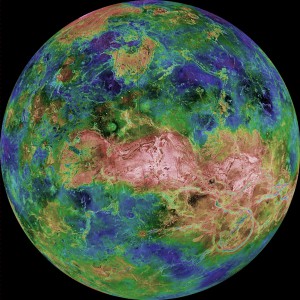
This hemispheric view of Venus, as revealed by more than a decade of radar investigations culminating in the 1990-1994 Magellan mission, is centered at 90 degrees east longitude. The Magellan spacecraft imaged more than 98 percent of Venus at a resolution of about 100 meters; the effective resolution of this image is about 3 kilometers.
Credit: NASA/JPL-CalTech
Most of the lower Venusian atmosphere consists of extremely hot carbon dioxide under tremendous pressures. The gas near the surface behaves like a supercritical fluid, says Garvin. Prior to the recent development of two test chambers at Goddard Space Flight Center and the Jet Propulsion Laboratory, NASA didnt have a way to test to Venusian conditions. Through a series of fortunate events, a one of several partnerships were established with a New England manufacturing company that required 500-degree-Celsius temperatures at 100 atmospheres pressure for some of its specialty products.
Choosing a place to land is also challenging. Before the Mars Science Laboratory (MSL) and its Curiosity rover, NASA landers and rovers have essentially touched down in the equivalent of parking lots: flat, not too rocky, and relatively safe. MSL will deviate from this paradigm. Now were going to the really interesting spots, Garvin says. Before we couldnt go to these places because we didnt have the engineering and supporting knowledge to get us there. On Venus, were not even sure where the good stuff is because we cant do the kind of remote sensing we do on Mars because of its big atmosphere. But we know that newly advanced radar methods can give us views of Venus nearly equivalent to those of Mars, perhaps some day.
The interest in Venus is there. In the last round of NASAs openly-competed Discovery missions, seven were bid to study Venus—more than any other planet or celestial body. What is challenging for Venus-hungry explorers is telling a compelling science story. How do you communicate that? You go to the public and say you want to spend 500 million dollars on Venus sniffing sulfur isotopes, searching for a part per billion of water in a rock, and take a few pictures of rocks. Meanwhile, we’re looking for prebiotic chemistry on Mars, or oceans on Europa, or lakes of ethane on Titan, says Garvin. Exploring Venus will hinge on a combination of reality and economics.
“What path can you take on a shrinking budget with lots of other good things to do? he asks. Mars? Europa? Titan? That’s the challenge we face.” Surveying the difficult choices for planetary exploration, he notes that while important to study, Venus isn’t going anywhere. “We could be missing parts of the equation, Garvin says. For now, Venus will wait. The Rolling Stones said, Time waits for no one. But in this case, Venus will wait.”







